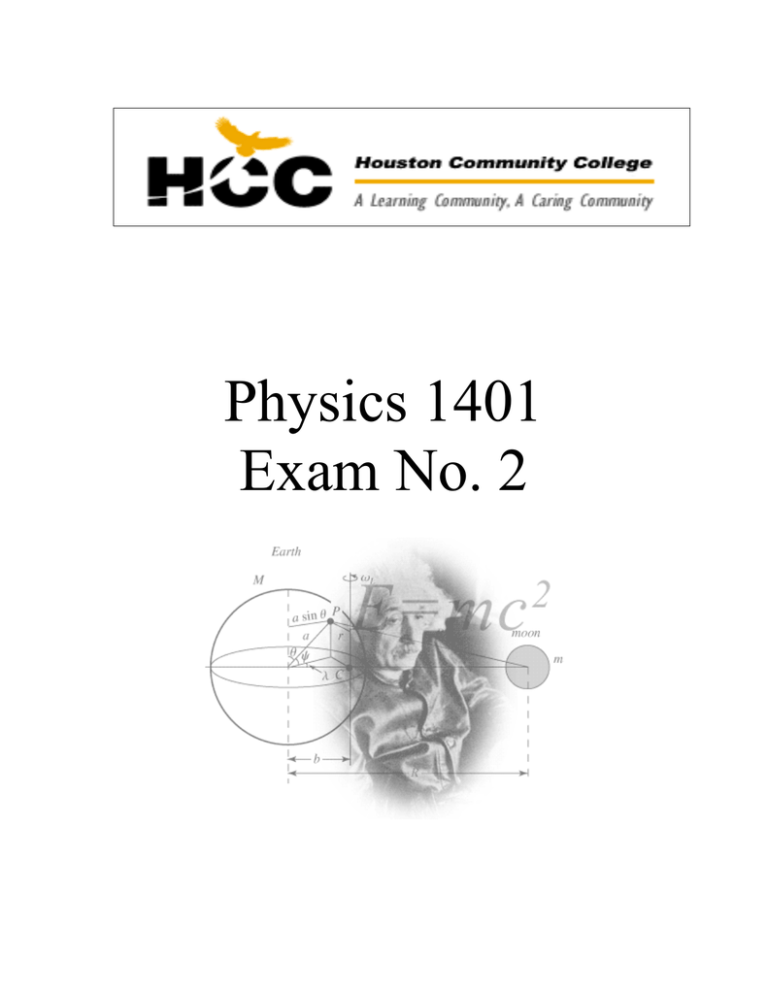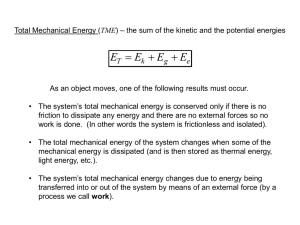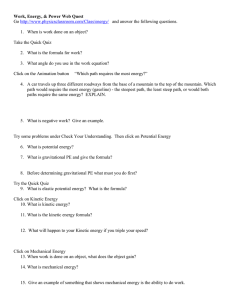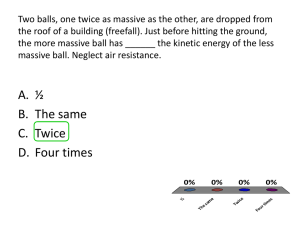Physics 1401Test2F10.doc
advertisement

Physics 1401 Exam No. 2 Physic 1401 Test 2 Name___________________ Instructions: Show ALL work for partial credit. Box your final answer so I can find it. 1.) An elastic collision is one in which: a.) momentum is not conserved but kinetic energy is conserved. b.) momentum is conserved and kinetic energy is conserved c.) neither kinetic energy nor momentum is conserved d.) momentum is conserved but kinetic energy is not conserved 2.) A snowboarder has a mass of 50kg. The snowboarder is moving at 20m/s when he hits a frictionless upward slope of 5m followed by a downward drop of 10m. How fast is s/he going at the end of the run? a.) 24.4 m/s b.) 22.3 m/s c.) 9.9 m/s d.) 56.8 m/s 3.) A 200kg projectile is launched with a speed of 50m/s at an angle of 30o from level ground. How much Kinetic Energy will it have when it hits the ground? a.) 12,420 J b.) 250,000 J c.) 18,750 J d.) 490,248 J 4.) A 20kg box is dragged at constant speed over a rough surface with kinetic friction coefficient: k = 0.2. If the box is pulled by a rope at an angle of 30o relative to the horizontal for a distance of 10m, how much work must be done to drag the box? a.) 351.4J b.) 17.57 J c.) 256 J d.) 156 J 5.) A dog pulls an 80 kg sled up a frictionless 30o slope of snow. The force F that the dog pulls with is parallel to the slope. If the speed of the sled is Constant, how much work does the dog do by pulling the sled 2 m along the slope? a.) –210J b.) 80J c.) 149J d.) 784J 6.) A 2kg block is pressed against a spring of Spring Constant k = 80N/m. The block compresses the spring by 0. 2m. When the block is released how fast will the block move. There is no friction. a.) 3.33 m/s b.) 2.53 m/s c.) 1.26 m/s d.) 0.2 m/s 7.) A 0.07 kg bullet is fired at 200 m/s into a stationary 1.5 kg block of wood and after passing through the block is found to be traveling at 190 m/s. If the block of wood is on a frictionless surface, find the speed of the block after the bullet passes through. a.) 8.91 m/s b.) 4.53 m/s c.) 0.47 m/s d.) 0.21 m/s 8.) A wheel initially has an angular velocity of 26 rad/s but after 3 revolutions its angular velocity is 24 rad/s. If its angular acceleration is constant the value is: a.) - 2.65 rad/s2 b.) -5.62 rad/s2 c.) 3.0 rad/s2 d.) –1.46 rad/s2 9.) A truck tire has a radius of 0.5m. When the tire rolls through 2 revolution, how far forward will the wheel travel? a.) 6.3m b.) 12.6m c.) 2m d.) 2.6m 10.) A tennis player receives a tennis ball (m = 0.06 kg) traveling horizontally at a speed of 50m/s and returns the ball horizontally with a speed of 40m/s. What is the impulse delivered to the ball by the tennis racquet? a.) 4.5 kgm/s b.) 5.4 kgm/s c.) 6 kgm/s d.) 5.6 kgm/s Short Answer 11.) Since Energy can neither be created or destroyed, where does it go in an inelastic collision? 12.) Whenever an object makes it around a vertical loop the velocity at the top of the loop must be greater than or equal to (gR)1/2. Explain why this is the case. Show All Work 13.) Mass m1 = 10kg and starts at point A 10m above the ground. Mass m2 = 20kg and is initially at moving at 2m/s to the left when it is hit by m1 at point B. The masses then undergo a perfectly inelastic collision. a.) Find the speed of the masses as they leave point B after the collision. b.) How high does the combined mass go up the right hand ramp? 14.) A flat road curve has a radius of curvature of R = 50m and a coefficient of kinetic friction k = 0.2. Find the maximum speed that one could safely go around the curve. For full points show your work including a free body diagram. 15.) The 10kg mass starts 100m above the ground. The Loop is 10m high. The friction section is 5m long and has a friction coefficient of k = 0.2. a.) How fast will the mass be going after it goes through the friction? b.) What will be the Normal force at the top of the loop?




